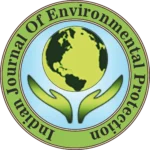IJEP 41(1): 100-106 : Vol. 41 Issue. 1 (January 2021)
Harendra K. Sharma 1*, Irfan Rashid Sofi1 and Laxmi Dubey2
1. Jiwaji University, School of Studies in Environmental Science, Gwalior – 474 001, M.P., India
2. SMS Govt. Model Science College, Department of Botany, Gwalior – 474 009, M.P., India
Abstract
The ability of potato peel to act as biosorption medium in the removal of metal ions from aqueous solution was investigated. The adsorbent removal efficiency was determined as a function of contact time, initial metal ion concentration, pH and temperature. Potato peel was characterized by scanning electron microscopy (SEM) and Fourier transformed infrared spectroscopy (FTIR). FTIR results showed that the functional groups providing the active sites are carboxyl, hydroxyl and carbonyl groups. Results from the biosorption experiment showed that potato peel displays a good binding affinity with metals ions [Cr(VI) and Ni(II)] in the aqueous solution. The equilibrium profile fits with the Langmuir isotherm with a coefficient values of 0.93 and 0.99 for Ni(II) and Cr(VI) and Freundlich isotherm having coefficient values of 0.97 and 0.99 for Ni(II) and Cr(VI), respectively. The potato peel was found to be highly efficient in the removal of selected heavy metal ions.
Keywords
Biosorption, Potato peel, Heavy metals, Aqueous solution, Adsorption isotherm
References
- Haware, D.J. and H.P. Pramod. 2011. Determination of specific heavy metals in fruit juices using atomic absorption spectrophotometer. Int. J. Res. Chem. Env., 4: 163-168.
- Zhang, X., et al. 2011. Assessing the toxicity of naphthenic acids using a microbial genome wide live cell reporter array system. Env. Sci. Tech., 45(5):1984-1991.
- Prakasham, R.S., et al. 1999. Biosorption of chromium VI by free and immobilized Rhizopus arrhizus. Env. Poll., 104: 421-427.
- WHO. 2014. World cancer report. Ed B. W. Stewart and C. P. Wild. International Agency for Research on Cancer, World Health Organization, Geneva.
- Dubey, L., H.K. Sharma and R.K. Khare. 2017. Removal of zinc and lead from aqueous solution using low cost bioadsorbent Pennisetum glaucum (Bajara) husk. Adv. Biores., 8:188-196.
- Bai, R.S. and T.E. Abraham. 2003. Studies on chromium (VI) adsorption–desorption using immobilized fungal biomass. Bioresour. Tech., 87: 17-26.
- Bailey, S.E., et al. 1999. A review of potentially low-cost sorbents for heavy metals. Water Resour. Res., 33: 2469-2479.
- Ucun, H., et al. 2002. Biosorption of chromium (VI) from aqueous solution by cone biomass of Pinussyl vestris. Bioresour. Tech., 85:155-158.
- Zuo, X.J., et al. 2012. Biosorption of copper, zinc and cadmium using sodium hydroxide immersed Cymbopogon schoenanthus L, Spreng (lemon grass). Ecol. Eng., 49: 186-18.
- Bingol, A., et al. 2004. Removal of chromate anions from aqueous stream by a cationic surfactant modified yeast. Bioresour. Tech., 94: 245-249.
- Sciban, M.B., M.T. Klasnja and M.G. Antov. 2011. Study of the biosorption of different heavy metal ions onto Kraft lignin. Ecol. Eng., 37: 2092-2095.
- Singh, L., et al. 2012. Effective removal of Cu2+ions from aqueous medium using alginate as biosorbent. Ecol. Eng., 38: 119-124.
- Areco, M.M., et al. 2012. Biosorption of Cu(II), Zn(II), Cd(II) and Pb(II) by dead biomasses of green alga Ulva lactuca and the development of a sustainable matrix for adsorption implementation. J. Hazard. Mater., 213-214:123-132.
- Bulgariu, D. and L. Bulgariu. 2012. Equilibrium and kinetics studies of heavy metal ions biosorption on green algae waste biomass. Bioresour. Tech., 103: 489-493.
- Cabatingan, L.K., et al. 2001. Potential of biosorp-tion for the recovery of chromate in industrial was-tewaters. Ind. Eng. Chem. Res., 40: 2302-2309.
- Lee, Y.C. and S.P. Chang. 2011. The biosorption of heavy metals from aqueous solution by Spirogyra and Cladophora filamentous macroalgae. Bioresour. Tech., 102: 5297-5304.
- Iqbal, M., A. Saeed and S.I. Zafar. 2008. FTIR spectrophotometry, kinetics and adsorption isotherm modeling, ion exchange and EDX analysis for understanding the mechanism of Cd2+and Pb2+removal by mango peel waste. J. Hazard. Mater., 164: 161-171.
- Sharma, H.K., I.R. Sofi and K.A. Wani. 2018. Low cost absorbents, techniques and heavy metal removal efficiency. In Biostimulation remediation technologies for groundwater contaminants. IGI Global. pp 50-79.
- Helgi Library. 2019. Potato consumption per capita in India. Helgi Analytics, Czech Republic.
- Pratt, D.Y., L.D. Wilson and J.A. Kozinski. 2013. Preparation and sorption studies of glutaraldehyde cross-linked chitosan copolymers. J. Colloid Interface Sci., 395:205-211.
- Pandharipande, S.L. and R.P. Kalnake. 2013. Tama rind fruit shell adsorbent synthesis, characterization and adsorption studies for removal of Cr(VI) ions from aqueous solution. Int. J. Emerging Res. Eng. Sci., 4: 83-89.
- Mutongo, F., O. Kuipa and P.G. Kuipa. 2014. Removal of Cr(VI) from aqueous solutions using powder of potato peelings as a low cost sorbent. Bioinorganic Chem. Applications. DOI: 10.1155/2014/973153.
- El-Said, A.G. 2010. Biosorption of Pb(II) ions from aqueous solutions onto rice husk and its ash. American J. Sci., 6: 143-150.
